Types of Organisational Structures: their Advantages and Disadvantages!
All managers must bear that there are two organisations they must deal with-one formal and the other informal.The formal organisation in usually delineated by an organisational chart and job descriptions. The official reporting relationships are clearly known to every manager.Alongside the formal organisation exists are informal organisation which is a set of evolving relationships and patterns of human interaction within an organisation that are not officially prescribed.
Formal organisational structures are categorised as:
- Line organisational structure.
- Staff or functional authority organisational structure.
- Line and staff organisational structure.
- Committee organisational structure.
- Divisional organisational structure.
- Project organisational structure.
- Matrix organisational structure and
- Hybrid organisational structure.
These organisational structures are briefly described in the following paragraphs:
1. Line Organisational Structure:
A line organisation has only direct, vertical relationships between different levels in the firm. There are only line departments-departments directly involved in accomplishing the primary goal of the organisation. For example, in a typical firm, line departments include production and marketing. In a line organisation authority follows the chain of command.
Exhibit 10.3 illustrates a single line organisational structure.
Features:
- Has only direct vertical relationships between different levels in the firm.
Advantages:
- Tends to simplify and clarify authority, responsibility and accountability relationships
- Promotes fast decision making
- Simple to understand.
Disadvantages:
- Neglects specialists in planning
- Overloads key persons.
Some of the advantages of a pure line organisation are:
- A line structure tends to simplify and clarify responsibility, authority and accountability relationships. The levels of responsibility and authority are likely to be precise and understandable.
- A line structure promotes fast decision making and flexibility.
- Because line organisations are usually small, managements and employees have greater closeness.
However, there are some disadvantages also. They are:
- As the firm grows larger, line organisation becomes more ineffective.
- Improved speed and flexibility may not offset the lack of specialized knowledge.
- Managers may have to become experts in too many fields.
- There is a tendency to become overly dependent on the few key people who an perform numerous jobs.
2. Staff or Functional Authority Organisational Structure
The jobs or positions in an organisation can be categorized as:
- Line position: a position in the direct chain of command that is responsible for the achievement of an organisation’s goals and
- Staff position: A position intended to provide expertise, advice and support for the line positions.
The line officers or managers have the direct authority (known as line authority) to be exercised by them to achieve the organisational goals. The staff officers or managers have staff authority (i.e., authority to advice the line) over the line. This is also known as functional authority.
An organisation where staff departments have authority over line personnel in narrow areas of specialization is known as functional authority organisation. Exhibit 10.4 illustrates a staff or functional authority organisational structure.
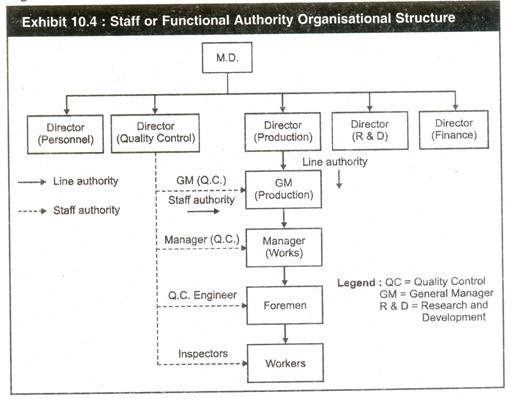
In the line organisation, the line managers cannot be experts in all the functions they are required to perform. But in the functional authority organisation, staff personnel who are specialists in some fields are given functional authority (The right of staff specialists to issue orders in their own names in designated areas).
The principle of unity of command is violated when functional authority exists i.e., a worker or a group of workers may have to receive instructions or orders from the line supervisor as well as the staff specialist which may result in confusion and the conflicting orders from multiple sources may lead to increased ineffectiveness. Some staff specialists may exert direct authority over the line personnel, rather than exert advice authority (for example, quality control inspector may direct the worker as well as advise in matters related to quality).
While this type of organisational structure overcomes the disadvantages of a pure line organisaional structure, it has some major disadvantages:They are;
- the potential conflicts resulting from violation of principle of unity of command and
- the tendency to keep authority centralized at higher levels in the organisation.
3. Line and Staff Organisational Structure:
Most large organisations belong to this type of organisational structure. These organisations have direct, vertical relationships between different levels and also specialists responsible for advising and assisting line managers. Such organisations have both line and staff departments. Staff departments provide line people with advice and assistance in specialized areas (for example, quality control advising production department).
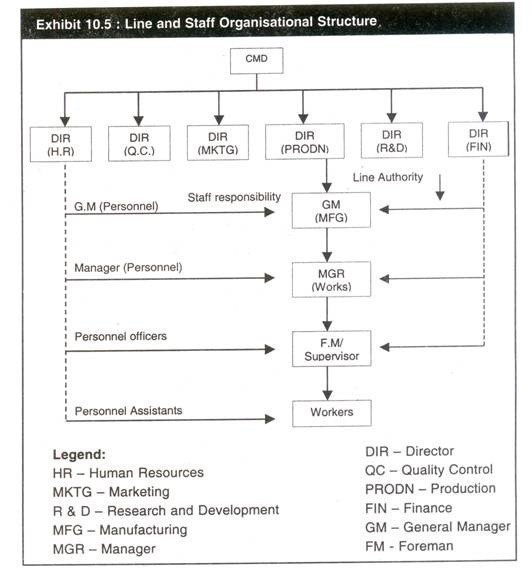
Exhibit 10.5 illustrates the line and staff organisational chart. The line functions are production and marketing whereas the staff functions include personnel, quality control, research and development, finance, accounting etc. The staff authority of functional authority organisational structure is replaced by staff responsibility so that the principle of unity of command is not violated.
Three types of specialized staffs can be identified:
- Advising,
- Service and
- Control.
Some staffs perform only one of these functions but some may perform two or all the three functions. The primary advantage is the use of expertise of staff specialists by the line personnel. The span of control of line managers can be increased because they are relieved of many functions which the staff people perform to assist the line.
Some advantages are:
- Even through a line and staff structure allows higher flexibility and specialization it may create conflict between line and staff personnel.
- Line managers may not like staff personnel telling them what to do and how to do it even though they recognize the specialists’ knowledge and expertise.
- Some staff people have difficulty adjusting to the role, especially when line managers are reluctant to accept advice.
- Staff people may resent their lack of authority and this may cause line and staff conflict.
Its Features are:
- Line and staff have direct vertical relationship between different levels.
- Staff specialists are responsible for advising and assisting line managers/officers in specialized areas.
- These types of specialized staff are (a) Advisory, (b) Service, (c) Control e.g.,
- Advisory: Management information system, Operation Research and Quantitative Techniques, Industrial Engineering, Planning etc
- Service: Maintenance, Purchase, Stores, Finance, Marketing.
- Control: Quality control, Cost control, Auditing etc.
The Advantages’
- Use of expertise of staff specialists.
- Span of control can be increased
- Relieves line authorities of routine and specialized decisions.
- No need for all round executives.
The Disadvantages are as follows:
- Conflict between line and staff may still arise.
- Staff officers may resent their lack of authority.
- Co-ordination between line and staff may become difficult.
Committee Organisational Structure Features:
- Formed for managing certain problems/situations
- Are temporary decisions.
Advantages are as follows:
- Committee decisions are better than individual decisions
- Better interaction between committee members leads to better co-ordination of activities
- Committee members can be motivated to participate in group decision making.
- Group discussion may lead to creative thinking.
The Disadvantages are:
- Committees may delay decisions, consume more time and hence more expensive.
- Group action may lead to compromise and indecision.
- ‘Buck passing’ may result.
4. Divisional Organisational Structure:
In this type of structure, the organisation can have different basis on which departments are formed. They are:
- Function,
- Product,
- Geographic territory,
- Project and
- Combination approach.
Exhibit 10.6 illustrates organisational structures formed based on the above basis of departmentation.
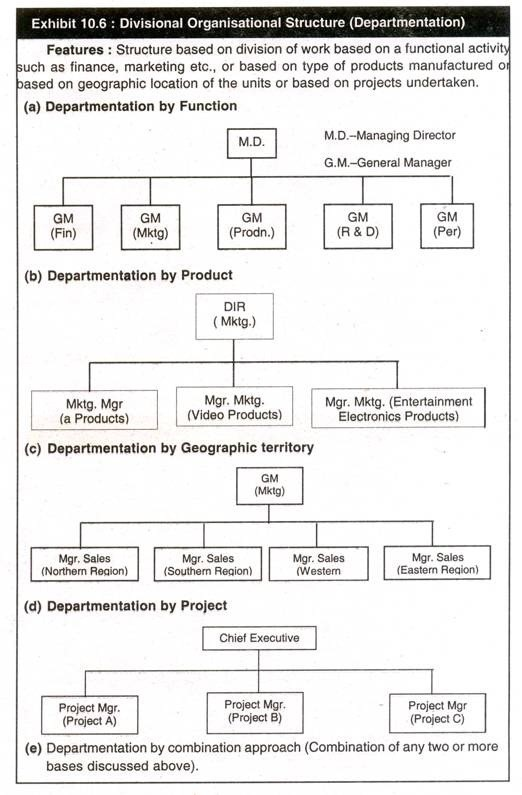
5. Project Organisational Structure:
The line, line and staff and functional authority organisational structures facilitate establishment and distribution of authority for vertical coordination and control rather than horizontal relationships. In some projects (complex activity consisting of a number of interdependent and independent activities) work process may flow horizontally, diagonally, upwards and downwards. The direction of work flow depends on the distribution of talents and abilities in the organisation and the need to apply them to the problem that exists. The cope up with such situations, project organisations and matrix organisations have emerged.
A project organisation is a temporary organisation designed to achieve specific results by using teams of specialists from different functional areas in the organisation. The project team focuses all its energies, resources and results on the assigned project. Once the project has been completed, the team members from various cross functional departments may go back to their previous positions or may be assigned to a new project. Some of the examples of projects are: research and development projects, product development, construction of a new plant, housing complex, shopping complex, bridge etc.
Exhibit 10.7 illustrates a project organisational structure.
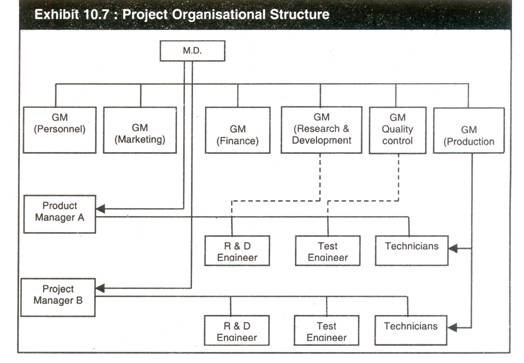
The Features are:
- Temporary organisation designed to achieve specific results by using teams of specialists from different functional areas in the organisation.
Importance of Project Organisational Structure:
Project organisational structure is most valuable when:
- Work is defined by a specific goal and target date for completion.
- Work is unique and unfamiliar to the organisation.
- Work is complex having independent activities and specialized skills are necessary for accomplishment.
- Work is critical in terms of possible gains or losses.
- Work is not repetitive in nature.
Characteristics of project organisation:
- Personnel are assigned to a project from the existing permanent organisation and are under the direction and control of the project manager.
- The project manager specifies what effort is needed and when work will be performed whereas the concerned department manager executes the work using his resources.
- The project manager gets the needed support from production, quality control, engineering etc. for completion of the project.
- The authority over the project team members is shared by project manager and the respective functional managers in the permanent organisation.
- The services of the specialists (project team members) are temporarily loaned to the project manager till the completion of the project.
- There may be conflict between the project manager and the departmental manager on the issue of exercising authority over team members.
- Since authority relationships are overlapping with possibilities of conflicts, informal relationships between project manager and departmental managers (functional managers) become more important than formal prescription of authority.
- Full and free communication is essential among those working on the project.
6. Matrix Organisational Structure:
It is a permanent organisation designed to achieve specific results by using teams of specialists from different functional areas in the organisation. The matrix organisation is illustrated in Exhibit 10.8.
Feature:
- Superimposes a horizontal set of divisions and reporting relationships onto a hierarchical functional structure
The Advantages:
- Decentralised decision making.
- Strong product/project co-ordination.
- Improved environmental monitoring.
- Fast response to change.
- Flexible use of resources.
- Efficient use of support systems.
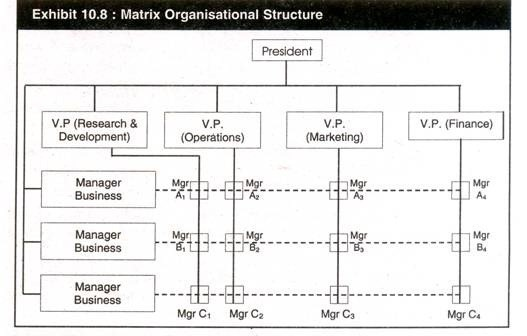
The Disadvantages:
- High administration cost.
- Potential confusion over authority and responsibility.
- High prospects of conflict.
- Overemphasis on group decision making.
- Excessive focus on internal relations.
- This type of organisation is often used when the firm has to be highly responsive to a rapidly changing external environment.
- In matrix structures, there are functional managers and product (or project or business group) managers. Functional manager are in charge of specialized resources such as production, quality control, inventories, scheduling and marketing. Product or business group managers are incharge of one or more products and are authorized to prepare product strategies or business group strategies and call on the various functional managers for the necessary resources.
- The problem with this structure is the negative effects of dual authority similar to that of project organisation. The functional managers may lose some of their authority because product managers are given the budgets to purchase internal resources. In a matrix organisation, the product or business group managers and functional managers have somewhat equal power. There is possibility of conflict and frustration but the opportunity for prompt and efficient accomplishment is quite high.
7. Hybrid Organisational Structure:
Exhibit 10.9 (a) illustrates the hybrid organisational structure.
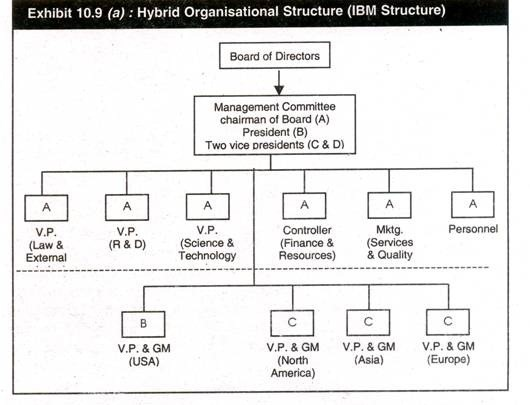
Exhibit 10.9 (b) illustrates a combination structure
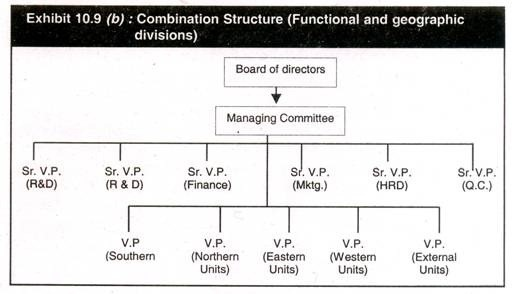
Its Advantages:
- Alignment of corporate and divisional goals.
- Functional expertise and efficiency.
- Adaptability and flexibility in divisions.
Its Disadvantages:
- Conflicts between corporate departments and units.
- Excessive administration overhead.
- Slow response to exceptional situations.
Its Uses:
- Used in organisations that face considerable environmental uncertainty that can be met through a divisional structure and that also required functional expertise or efficiency
- This type of structure is used by multinational companies operating in the global environment, for example, International Business Machines USA. This kind of structure depends on factors such as degree of international orientation and commitment. Multinational corporations may have their corporate offices in the country of origin and their international divisions established in various countries reporting to the CEO or president at the headquarters. The international divisions or foreign subsidiaries may be grouped into regions such as North America, Asia, Europe etc. and again each region may be subdivided into countries within each region.
- While the focus is on international geographic structures, companies may also choose functional or process or product departmentation in addition to geographic pattern while at the head quarter’s the departmentation may be based on function.
The Informal Organisation:
An informal organisation is the set of evolving relationships and patterns of human interaction within an organisation which are not officially presented. Alongside the formal organisation, an informal organisation structure exists which consists of informal relationships created not by officially designated managers but by organisational members at every level. Since managers cannot avoid these informal relationships, they must be trained to cope with it
The informal organisation has the following characteristics
- Its members are joined together to satisfy their personal needs (needs for affiliation, friendship etc.)
- It is continuously changing: The informal organisation is dynamic.
- It involves members from various organisational levels.
- It is affected by relationship outside the firm.
- It has a pecking order: certain people are assigned greater importance than others by the informal group.
Even though an informal organisational structure does not have its own formal organisational chart, it has its own chain of command:
Benefits of Informal Organisation:
- Assists in accomplishing the work faster.
- Helps to remove weakness in the formal structure.
- Lengthens the effective span of control.
- Compensation for violations of formal organisational principles.
- Provides an additional channel of communication.
- Provides emotional support for employees.
- Encourages better management.
Disadvantages of informal organisation:
- May work against the purpose of formal organisation.
- Reduces the degree of predictability and control.
- Reduces the number of practical alternatives.
- Increases the time required to complete activities.
Principles of organization
- Principle of unity of objectives: Organizational goals, departmental goals, and individual goals must be clearly defined. All goals and objectives must have uniformity. When there is contradiction among different level of goals desired goals can’t be achieved. Therefore, unity of objectives is necessary
- Principle of specialization: Sound and effective organization believes on organization. The term specialization is related to work and employees. When an employee takes special type of knowledge and skill in any area, it is known as specialization. Modern business organization needs the specialization, skill and knowledge by this desired sector of economy and thus, efficiency would be established.
- Principle of coordination: In an organization many equipment, tools are used. Coordination can be obtained by group effort that emphasize on unity of action. Therefore, coordination facilitates in several management concepts
- Principle of authority: Authority is the kind of right and power through which it guides and directs the actions of others so that the organizational goals can be achieved. It is also related with decision making. It is vested in particular position, not to the person because authority is given by an institution and therefore it is legal. It generally flows from higher level to lowest level of management. There should be unbroken line of authority.
- Principle of responsibility: Authentic body of an organization is top level management, top level management direct the subordinates. Departmental managers and other personnel take the direction from top level management to perform the task. Authority is necessary to perform the work .only authority is not provided to the people but obligation is also provided. So the obligation to perform the duties and task is known as responsibility. Responsibility can’t be delegated. It can’t be avoided.
- Principle of delegation: Process of transferring authority and creation of responsibility between superior and subordinates to accomplish a certain task is called delegation of authority. Authority is only delegated, not responsibilities in all levels of management. The authority delegated should be equal to responsibility
- Principle of efficiency: In enterprise different resources are used. Therese resources must be used in effective manner. When the organization fulfill the objectives with minimum cost, it is effective. Organization must always concentrate on efficiency.
- Principle of unity of command: subordinates should receive orders from single superior at a time and all subordinates should be accountable to that superior. More superior leads to confusion, delay and so on.
- Principle of span of control: unlimited subordinates cant be supervised by manager, this principle thus helps to determine numerical limit if subordinates to be supervised by a manager. This improves efficiency.
- Principle of balance: the functional activities their establishment and other performances should be balanced properly. Authority, centralization, decentralization must be balance equally. This is very challenging job but efficient management must keep it.
- Principle of communication: Communication is the process of transformation of information from one person to another of different levels. It involves the systematic and continuous process of telling, listening and understanding opinions ideas, feelings, information, views etc, in flow of information. Effective communication is important
- Principle of personal ability: for sound organization, human resources is important. Employees must be capable. Able employees can perform higher. Mainly training and development programs must be encouraged to develop the skill in the employees
- Principle of flexibility: organizational structure must be flexible considering the environmental dynamism. Sometimes, dramatically change may occur in the organization and in that condition, organization should be ready to accept the change
- Principle of simplicity: this principles emphasizes the simplicity of organizational structure, the structure if organization should be simple with minimum number of levels do that its member an understand duties and authorities.
Sound Policy
Explain the Sound Policy
Line of Authority
Explain the Line of authority
LINE AUTHORITY: The most fundamentalauthoritywithin an organization, reflects existing superior-subordinate relationships. It consists of the right to make decisions and to give order concerning the production,sales or finance related behaviour of subordinates.D
Simple, Plain and Elaborate Organization
Explain Simple, plain and elaborate organization
Unity - Chain of Command
Explain the Unity - chain of command
Unity of commandprovides that an employee is responsible to only one supervisor, who in turn is responsible to only one supervisor, and so on up the organizational hierarchy. This is true even if the top of the organization is led by a group of people. For example, imagine you are the CEO of a technology firm in Silicon Valley. While the board of directors of your company governs the policy making and strategic planning, under the concept of unity of command, you do not answer to all members of the board, but only the chairman of the board.
Responsibility
Explain the Responsibility
A duty or obligation to satisfactorily perform or complete a task (assigned by someone, or created by one's own promise or circumstances) that one must fulfill, and which has a consequent penalty for failure.
Equity Treatment
Explain the Equity treatment
Measurement of Effectiveness
Explain the Measurement of effectiveness
Measures ofEffectiveness(MOE) Measures ofEffectiveness(MOE) aremeasuredesigned to correspond to accomplishment of mission objectives and achievement of desired results. They quantify the results to be obtained by a system and may be expressed as probabilities that the system will perform as required.
Span Of Control
Explain the Span of control
Terrance is a supervisor at MegaCorp, a large, multinational conglomerate. He works in the product division, overseeing a team that assembles components for computers. Terrance can only effectively manage a certain number of people at one time. On the other hand, if he manages too few, the company will not operate efficiently, and that costs money.
The number of employees that can be controlled directly by a manager is called the manager'sspan of control. Span of control depends on such factors as the type of work, the complexity of the work and the variability of the work task. Let's look at some examples.
Terrance's team works in a very controlled environment because of the fragility of the electronic components, such as motherboards, video cards and audio cards, that must be installed. Additionally, installation is somewhat complex and time consuming. Terrance's span of control is, therefore, fairly narrow.
Let's say that Terrance decides to pull some overtime in the packaging department. Now Terrance is supervising a team that is packing up Ethernet cables that are sold separately as an accessory. The cables are pretty durable and all the team is doing is putting individual display packages into shipping boxes for delivery to the company's retail distributors.
Given the relative simplicity of the task, Terrance's span of control can be much broader. In other words, he can manage many more employees at the same time compared to when he is managing his regular team installing computer components.

